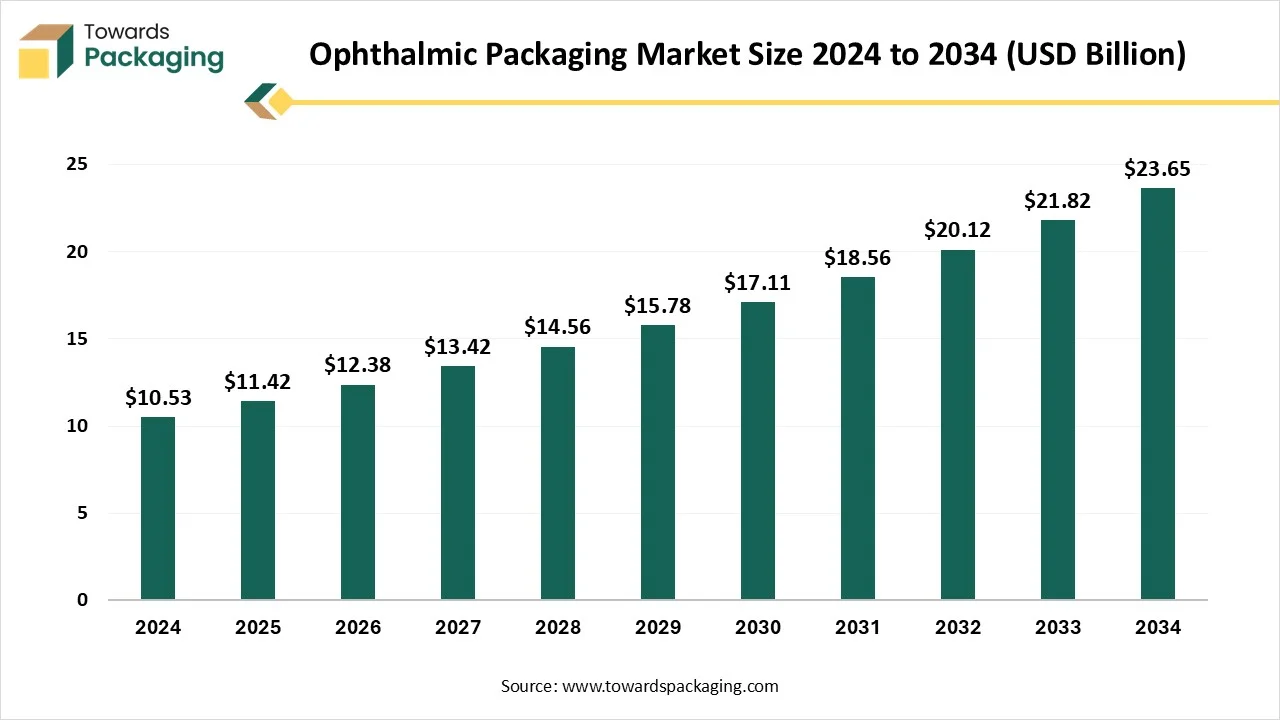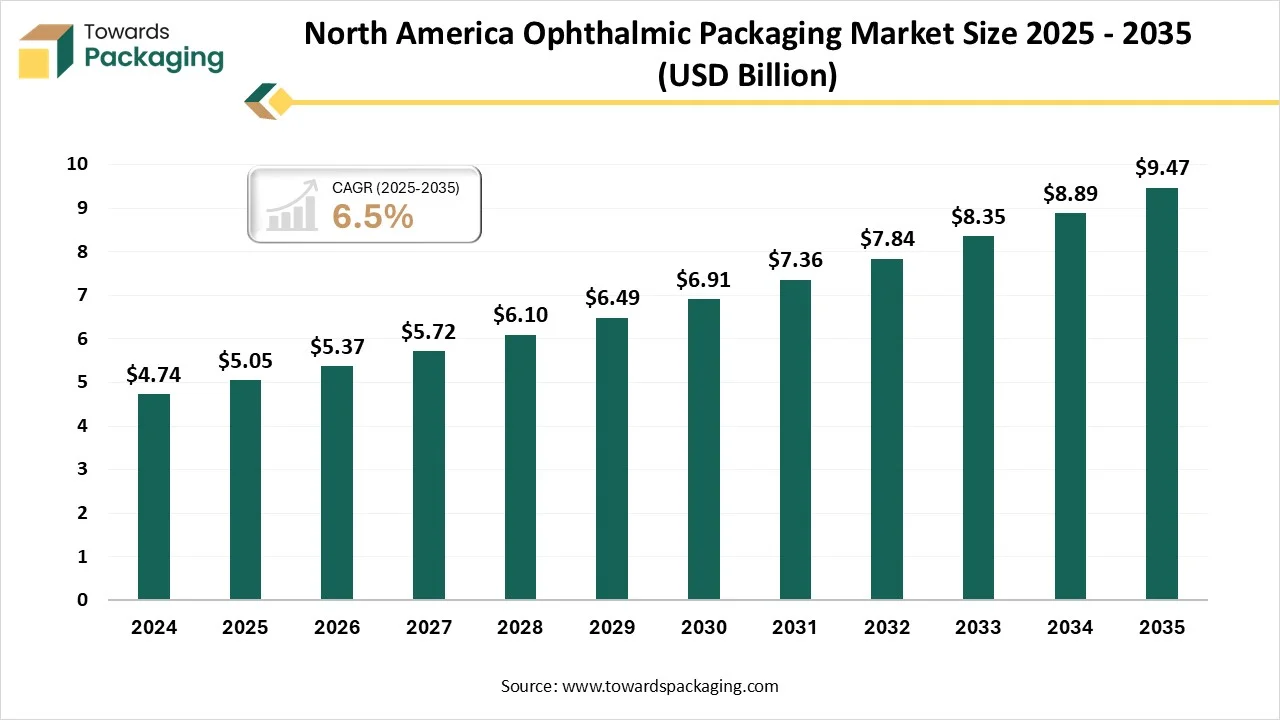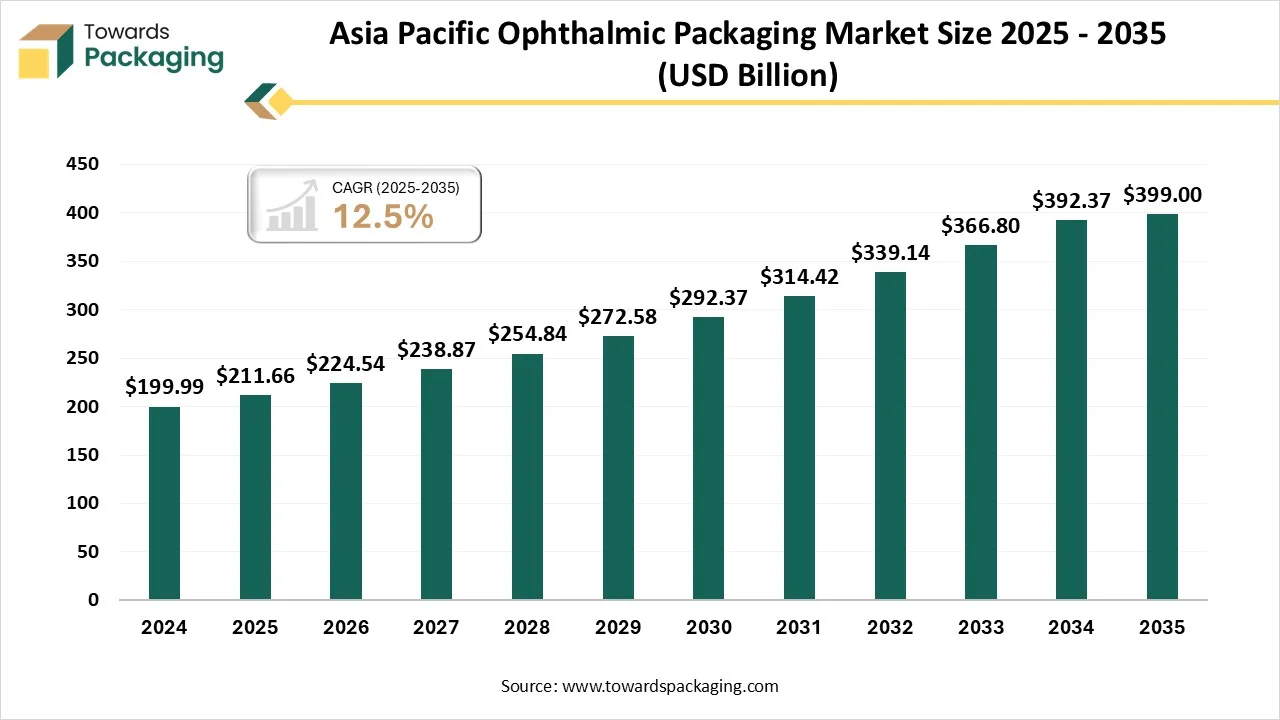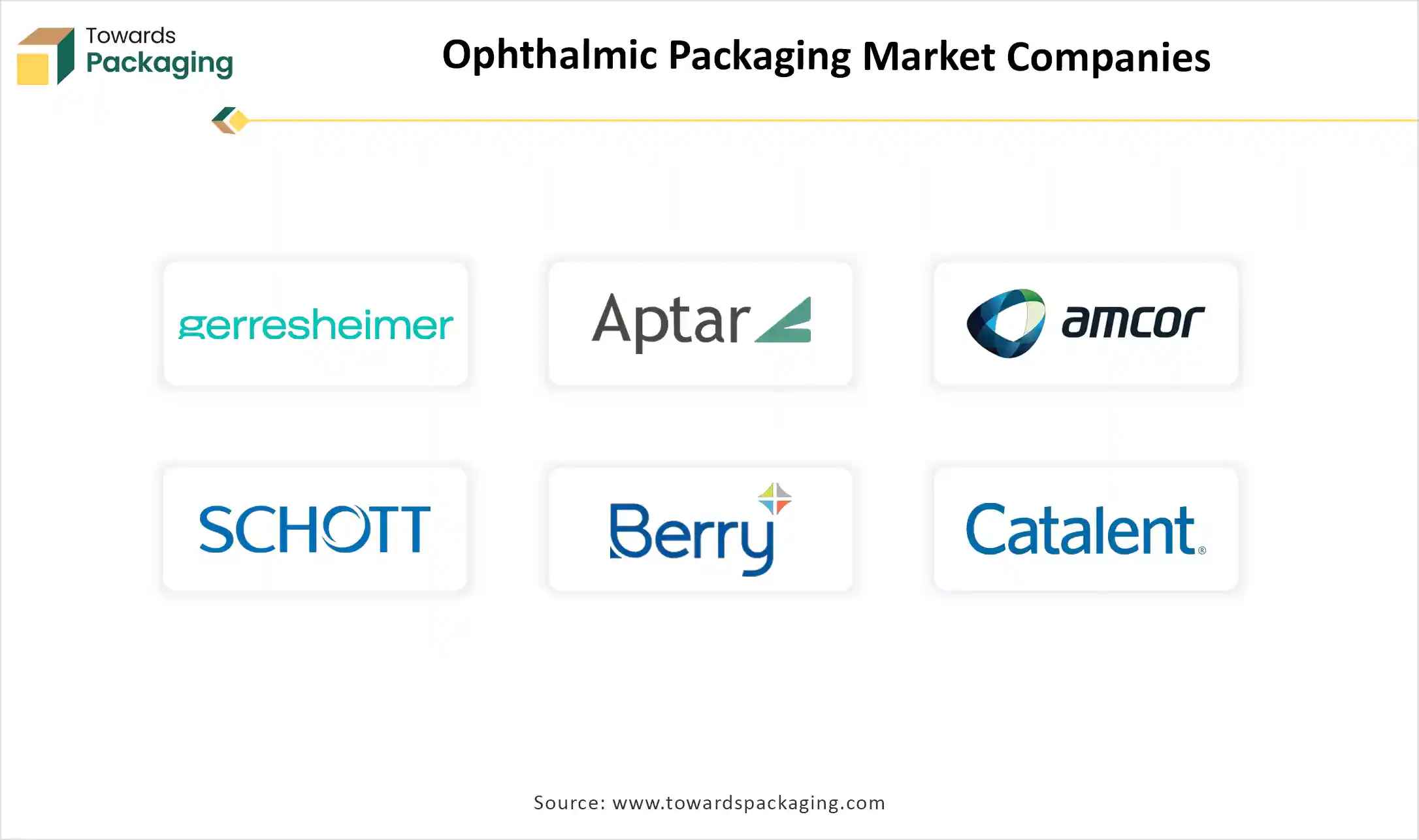The ophthalmic packaging market is projected to grow from USD 18.36 billion in 2026 to USD 37.39 billion by 2035, registering a strong 8.43% CAGR (2025–2034). This report covers complete segmentation by packaging type (bottles, vials, blister packs, droppers), material (PE, PP, glass, aluminum), and applications (prescription, OTC, surgical ophthalmics). It provides regional insights across North America, Europe, Asia-Pacific, Latin America, and the Middle East & Africa, along with profiles of major companies, competitive analysis, value chain mapping, and global trade data for raw materials and finished ophthalmic containers.

The ophthalmic packaging market refers to the specialized packaging solutions used to store, preserve, and dispense ophthalmic pharmaceutical products, including eye drops, ointments, and gels. These packaging formats are designed to maintain the sterility, efficacy, and shelf life of the contents while ensuring accurate dosing and user-friendly application. Packaging types include bottles, tubes, droppers, vials, blister packs, and multi-dose containers, often designed to be tamper-evident, contamination-resistant, and suitable for single or multiple uses.
Packaging for ophthalmic medicines is a space that needs high-level solutions to align with increasingly complicated clinical and regulatory requirements. Invention in this field concentrates not only on drug protection and preservation, but also on the patient's user experience, making sure of safety, convenience of administration, and sustainability. As technologies develop, the future of ophthalmic packaging will be heavily customer-centric towards environmentally-friendly solutions, intelligent, and developing the quality of eye care globally.
Developments in Artificial Intelligence (AI) have introduced intelligent solutions whose goal is to solve some challenges. One noticeable invention is the smart electronic eye drop container, crafted to discreetly manage eye drop usage. Filled with sensors, the device manages the frequency and timing of eye drop administration, serving real-time data to both healthcare providers and patients. This quick response enables timely mediation and focused education, mainly developing adherence rates.
Additionally, mixing AI into ophthalmic care, smartphone-based uses now provide high-level help for patients. These applications use AI Algorithms to guide consumers through proper instillation procedures, set reminders for medication schedules, and even help in the treatment of eye conditions using the smartphone's camera. An organized review has highlighted the result of such procedures, showcasing their capabilities in patient tracking and telemedicine.
Eye Drives The Ophthalmic Packaging Sector
Eye-related diseases are becoming more prevalent due to an aging population, increased screen time, and the growing incidence of diabetes. As per the World Health Organization, over 2 million people experience vision impairment. This fuels the urge for ophthalmic pharmaceuticals and by stretching, robust packaging solutions. On the other hand, sterility is crucial in ophthalmology to avoid infection issues. Ophthalmic packaging materials are crafted to prevent microbial pollutants and ensure a tamper-evident experience for users, which is becoming a standard need in both developed and growing regions.
Unidose Container Is The Challenge
One major limitation or challenge is material compatibility, as the packaging must not react with sensitive ophthalmic formulations, which restricts the series of materials that can be used. Sterility maintenance is another challenge -once opened, multi-dose containers risk microbial contamination despite preservatives. Additionally, cost constraints can grow because ophthalmic packaging needs specialized sterile manufacturing. Tamper-evident sealing and accurate dosing systems, all of which increase expenses.
Several Injections Lead To Future Possibilities
Growing demand for sterile, ready-to-use preparations minimizes errors and minimizes contamination risk during intravitreal injections. Packaging designs that keep drug elements separate until use ensure extended shelf life and high formulation stability. Inventions in micro-needle and depot injection packaging can deliver drugs over weeks or months, reducing patient visits and improving adherence. Pre-packaged sterile kits having syringes, needles, and drug vials streamline surgical and in-office procedures, boosting convenience and sterility assurance. Also, opportunities exist for ophthalmic-specific injection systems with perfect grip, anti-needlestick mechanisms, and clear dose indicators to aid ophthalmologists.
How Did Bottles Segment Dominate The Packaging Type In The Ophthalmic Packaging Market?
The bottles segment dominated the market in 2024, bottles in ophthalmic packaging are a main solution for keeping and dispensing liquid eye care products such as antibiotic solutions, lubricating drops, glaucoma, and anti-allergy drops. They are crafted to track sterility, stability, and ease of application throughout the product’s shelf life. Typically, these bottles are manufactured from pharmaceutical-grade plastics like low-density polyethylene, high-density polyethylene, or polypropylene, chosen for their chemical resistance, flexibility, and compatibility with the drug formulation.
Multi-dose droppers segment expects the fastest growth in the ophthalmic packaging market during the forecast period. These luxury bottles are accurately suited for pharmaceutical products, and they can be utilised for preservative-free formulations. The multi-dose container has a highly accurate bottle neck that can be integrated with different dosing systems. Personalized to different dosing systems, multi-dose serves different applications, such as nasal sprays and eye drops. So, squeeze dropper systems with sterile packaging are for formulations. The bottle has a dropper cap and a system that develops intuitive dosing. An atmospheric bottle for metered dose uses of liquid formulations serves high user convenience. Having a patented spray pump and cross-profile bottom enables an updated spray design and accurate dosing.
Plastic (LDPE) segment dominated the market in 2024, Low-density polyethylene is one of the most widely used plastics in ophthalmic packaging, specifically for eye drop bottles and dispensing tips. Its popularity stems from its soft, squeezable texture, which enables patients to conveniently dispense controlled drops without excessive effort, a crucial feature for elderly users or those with limited hand strength. It observes excellent chemical resistance, making sure compatibility with a huge range of ophthalmic drug formulations, including aqueous and oil-based solutions. It is also highly inert, meaning it won't react with or absorb the active ingredients, thus protecting the efficacy and stability of the medication.
The polypropylene (PP) segment is expected to experience the fastest growth in the ophthalmic packaging market during the forecast period. Polypropylene is a widely used material in ophthalmic packaging, especially for closures, caps, certain bottle components, and certain bottle components. Its popularity comes from its high chemical resistance, cost-effectiveness, and durability, making it perfect for storing delicate eye care formulations such as lubricating drops, anti-allergy solutions, and medicated treatments. PP is lightweight yet strong, with excellent resistance to mixtures and many chemicals, making sure that the packaging does not react with or degrade the drug product. As compared to LDPE, it provides better rigidity, which is beneficial for elements that need structural stability, like threaded caps or tamper-evident seals.
The eye drops dominate the ophthalmic packaging market in 2024; A sterile liquid preparation created from API and suitable for injecting into the eye. It is most prevalently used in ophthalmic dosage form, which is quickly absorbed and plays a quick role. Due to the conjunctival sac carrying only 20ml of fluid, while the volume of 1 drop of eye fluid is about 39 ML, linked with the corneal tissue barrier and tear dilution, the assimilation amount of eye drops after penetrating the eye is less than 10%. Eye drops are the diagnosis of choice for several eye conditions, such as inflammation, infections, dry eye, allergies, and glaucoma, accounting for 90 % of the five commercial products in the worldwide eye medicine industry.
Gels segment expects the fastest growth in the ophthalmic packaging market during the forecast period. Ophthalmic gels are semi-solid eye medications created in aseptic gel form by suitable excipients and medicine. Its viscosity is huge, convenient to mix with tears, and can extend the action time of drugs. It reduces the puffiness as a cooling ingredient is used in eye gels, like caffeine, which helps to lower puffiness, making tired eyes appear more awake. Cucumber, aloe vera, and other soothing ingredients refresh the under-eye area, helping to calm tired skin. Under-eye gels are generally water-based, which makes them hydrating yet light. Accurate for anyone who wants moisture without a load or greasy feeling. Because of their non-greasy formula, under-eye gels work perfectly on all skin types, including combination and oily skin. Several under-eye gels have peptides and antioxidants that assist in reducing fine lines and protect against environmental changes.
Multi-dose packaging has dominated the market in 2024, as it refers to a packaging design or system crafted to have different doses of a medication or product in one single package. It is generally used in the pharmaceutical sector to serve as an easy and organised path of administering and dispensing medications over a prolonged period. The multi-dose packaging solution is an overall strategy to packaging that includes the design, distribution, and production of containers or packages with the potential of carrying several doses of a product. This procedure usually includes personalised packaging materials, like blister packs or strip packs, along with instructions to use and labelling too.
Preservative-free systems segment expects the fastest growth in the ophthalmic packaging market during the forecast period. Preservative systems are an important advancement in ophthalmic packaging, designed to solve concerns about ocular irritation, allergic reactions, and long-term damage caused by preservatives like benzalkonium chloride. Such systems are especially crucial for patients with chronic eye conditions who need frequent or long-term use of eye drops. With the growing demand for safer, more tolerable eye care items, preservative systems are predicted to diminish the luxury ophthalmic packaging segment in the coming years, specifically in dry eye, glaucoma, and post-surgical care markets.
The pharmaceutical companies have dominated the market in 2024, because the checking of pharmaceutical packaging material is important to make sure that it does not negatively affect the safety, stability, and efficacy of the product. The main goal is to examine, track, and control any physicochemical communication between the drug formulation and packaging material. A perfect packaging material should be non-reactive, completely inert, and have the potential to serve maximum shelf life while tracking the probity of the pharmaceutical product. Hence, packaging materials often have different additives such as stabilizers, anti-oxidants, monomers, contaminants, and lubricants, that can interact with the drug and capably alter their characteristics.
Contract manufacturing organizations segment expects the fastest growth in the ophthalmic packaging market during the forecast period. Contract Manufacturing Organizations play an important role in ophthalmic packaging by serving specialized manufacturing, filling, and sterile packaging solutions for eye care products such as eye drops, ointments, and gels. These CMOs serve advanced technologies like blow-full-seal systems, multi-layer barriers, and single-dose unit containers to ensure product sterility and patient safety. With growing regulatory requirements and demand for preservative-free ophthalmic formulations, CMOs support pharmaceutical companies by serving compliance-ready, cost-effective, and scalable packaging solutions.

North America dominated the market in 2024, as it showcases the global ophthalmic drug industry, driven by the growing importance of eye-related disorders, the strong presence of main market players, and favourable reimbursement policies. The region benefits from the high-level healthcare infrastructure, specifically in the United States, with high healthcare spending and fast acceptance of innovative ophthalmic medications. Mexico and Canada also contribute mainly to the regional industry, with rising awareness about eye conditions and growing access to high-level eye care diagnosis. The representation of well-established research companies and current clinical trials further extends the region's position in the overall market.

Asia Pacific expects the fastest growth in the ophthalmic packaging market during the forecast period. Asia-Pacific is the fastest-growing region because of a growing middle-class population, growing awareness of eye health, and fast urbanization. Countries like India, China, and Japan are witnessing incidences of diabetic retinopathy and refractive errors, which are driving sales of ophthalmic packaging and drugs. It is not just a main production hub but also the fastest-growing region for ophthalmic packaging. Strong demographic shifts, growing healthcare access, and strategic investments in eye care support this fast expansion, making it an important focus area for packaging manufacturers and pharmaceutical stakeholders alike.

By Packaging Type
By Material Type
By Dosage Form
By Usage Format
By End User
By Region
January 2026
December 2025
December 2025
December 2025